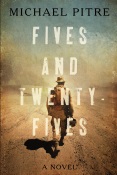An Indies Introduce Debut Author Q&A With Michael Pitre
 Michael Pitre is the author of Fives and Twenty-Fives (Bloomsbury USA), a 2014 Summer/Fall Indies Introduce title and a September Indie Next List pick. He is a graduate of Louisiana State University, where, as a double major in history and creative writing, he studied with Andrei Codrescu and Mark Jude Poirier. He joined the Marines in 2002, deploying twice to Iraq and attaining the rank of captain before leaving the service in 2010 to get his MBA at Loyola University. He lives in New Orleans.
Michael Pitre is the author of Fives and Twenty-Fives (Bloomsbury USA), a 2014 Summer/Fall Indies Introduce title and a September Indie Next List pick. He is a graduate of Louisiana State University, where, as a double major in history and creative writing, he studied with Andrei Codrescu and Mark Jude Poirier. He joined the Marines in 2002, deploying twice to Iraq and attaining the rank of captain before leaving the service in 2010 to get his MBA at Loyola University. He lives in New Orleans.
Fives and Twenty-Fives, Pitre’s first novel, is “a mesmerizing debut set in the Iraq war and its aftermath,” said Bill Cusumano of Nicola’s Books in Ann Arbor, Michigan. “The interlocking stories of the characters not only provide an incisive portrait of the state of current civilization but also a probing examination of individual responsibility and conscience. The author uses exceptional prose and character development to create a stark portrait of a world made by war. This novel will rightfully take its place next to Matterhorn and The Yellow Birds in the realm of modern combat literature.”
What inspired you to write Fives and Twenty-Fives?
Michael Pitre: I was an officer in the Marine Corps from 2002–2010, and I deployed to Anbar Province, Iraq, in 2006 and 2007. The Marines and the Iraqis with whom I served inspired the novel. The story is fictional, but I wrote it to honor the people I knew.
 What does the title, Fives and Twenty-Fives, refer to?
What does the title, Fives and Twenty-Fives, refer to?
MP: Fives and twenty-fives refers to a tactic used by U.S. service members in Iraq to maintain safe distances from possible roadside bombs. If the lead vehicle of a convoy spotted something suspicious on the road ahead, the convoy would halt to investigate. But as the insurgents learned our procedures, with particular attention paid to the spacing of our vehicles, they’d sometimes place a decoy device intended for us to see. The real device would be placed further back and better camouflaged, so that convoys stopped to investigate a fake device would be parked within the killing radius of a real one.
So, as a precaution, all halted vehicles would immediately execute a five and twenty-five meter sweep. First, from inside the vehicle the crew would scan five meters around the wheels to make sure they weren’t parked next to an IED. Then, a team would exit and sweep twenty-five meters in every direction to make sure there were no devices targeting dismounted bomb disposal units.
As the American experience in Iraq wore on, the phrase became a shorthand for protecting yourself and your friends. The phrase even came home with us. More than once, I overheard a Marine in a San Diego bar warn a drunk friend to watch his fives and twenty-fives.
What challenges do you face as a writer having multiple narrators? How did you switch gears, if you will, to get into a new character’s head?
MP: Knowing the challenge I was letting myself in for, I made sure that all three narrators were fully formed individuals in my imagination before I began work in earnest, and I gave myself exercises to refine their voices. I wrote a major portion of Kateb’s Huck Finn thesis, created long e-mail exchanges between Doc Pleasant and Zahn, and wrote dozens of after-action reports from Donovan’s point of view. Some of those exercises eventually made it into the novel in the form of chapter introductions.
As for switching gears, Kateb’s experience is so distinct, and his voice so acerbic, that getting into his headspace was never difficult. However, Donovan and Pleasant are both Southern guys, so there was a risk of overlap. I used the mantra “Alabama good boy and the Louisiana menace” to remind myself of the basic distinction between them.
In what ways do you think literature helps civilians better understand the experiences of military men and women, or the conflict as a whole? Do you think it’s equally important for returning soldiers?
MP: We’re emerging from a decade of continuous war fought entirely by volunteers. That’s unprecedented in American military history. A tiny percentage of the population is connected to the war, either through personal experience or the service of a loved one, and the result is a disconnect between veterans and the American public that has never been wider.
I do think literature can help bridge the gap when it’s done right. If the larger narratives, as seen on the evening news, can be reduced and distilled to a human level with relatable characters and visceral experiences, a view can be opened on the truth of modern war.
For veterans, I think faithful literary representations of their service can be a cathartic reminder that their sacrifices aren’t forgotten.
What kind of support is there for service men and women returning from war? Any organizations or charities you’d like our readers to be aware of?
MP: Service men and women returning to civilian life often find the best support comes from continued contact with one another. Veterans of Iraq and Afghanistan are passionate individuals motivated by a strong sense of duty, and that passion doesn’t go away when they take off the uniform. Team Rubicon is a perfect illustration. It’s a volunteer group of veterans using their military skills as first responders during natural disasters. They’ve been among the first NGOs on the ground in the Haiti, the Philippines, and Chile.
On a smaller scale, an influx of Iraq and Afghanistan veterans is reviving the VFW. The New Orleans VFW post (8973) is a good example. I was wary of joining, having imagined a dingy room filled with old guys in funny hats drinking stale beer and telling lies, but new membership has rebranded the post with an emphasis on service. They hold resume workshops, legal clinics, benefits outreach, and they’re renovating the dilapidated meeting hall into below-market-rate apartments for returning vets in need.
With improvements in battlefield medicine, hundreds of service members are coming home from Iraq and Afghanistan with wounds that would’ve meant certain death in previous wars. Survivors of double and triple amputations are not uncommon. Again, these are enthusiastic young men and women who joined in a time of war with a strong desire to serve. They need more than prosthetics; they need to know that they’re still valued. To that end, the Wounded Warrior Project does outstanding work. I’ll also give a plug to an organization in Montana called Warriors & Quiet Waters, run by my friend Seth Jordan, a former Marine Corps helicopter pilot. They organize fly fishing trips and other therapeutic wilderness excursions for wounded veterans.
Were books an important facet of your childhood? If so, what book had the greatest impact on you as a child?
MP: I was a voracious reader as a child, mostly because my family moved every few years and I was never very good at making new friends. So, I just stayed inside and read everything in the house.
When I was 11, I discovered the Horatio Hornblower novels by C.S. Forester. I read them obsessively, and supplemented them with books on 19th century seamanship and the Napoleonic Wars. The stories were full of action and adventure, but I think my real attraction was the awkwardness and vulnerability of the Horatio character. He’s quiet and full of self-doubt, but he succeeds through quickness of wit and sheer force of will. That was a very hopeful message for me when I was 11.
Are you working on anything now?
MP: I am. It’s a novel set in Louisiana during the last year of the Civil War and at the end of Reconstruction in 1881. I’m a Louisianan to the core, but having spent my childhood elsewhere gives me something of an outsider’s perspective. I’ve always been bothered by the way Southerners celebrate Confederate military history without acknowledging the evil at the heart of the Confederate cause. The novel follows several interconnected storylines from the end of the Civil War to the birth of Jim Crow. Hopefully, the novel will address some of the issues left unresolved by Reconstruction, the effects of which linger to this day.
If you were a bookseller for a day, what book would you want to put in every customer’s hands?
MP: Cryptonomicon, by Neal Stephenson. I’m an unrepentant Stephenson nerd. I find him to be the most compulsively readable author working today.
If you could meet any author, past or present, who would it be?
MP: That’s tough. It’s a toss-up between Dorothy Parker and Mark Twain. Annie Proulx takes a close third place.
Fives and Twenty-Fives by Michael Pitre (Bloomsbury USA, Hardcover, 9781620407547). Publication date: August 26, 2014.
Learn more about Michael Pitre at bloomsbury.com/author/michael-pitre.
ABA member stores are invited to use this interview or any others in our series of Q&As With Indies Introduce Debut Authors in newsletters and social media and in online and in-store promotions. Please let us know if you do.

